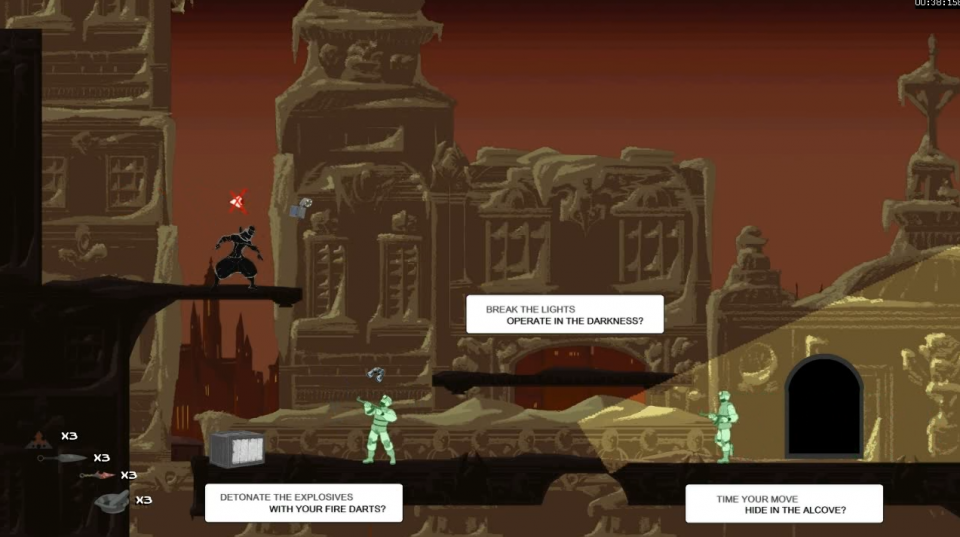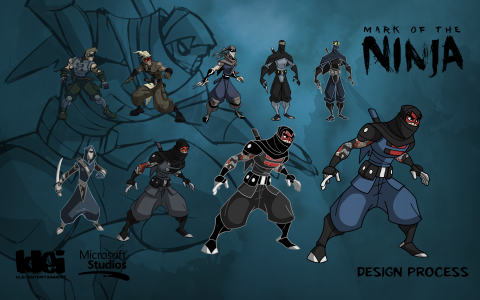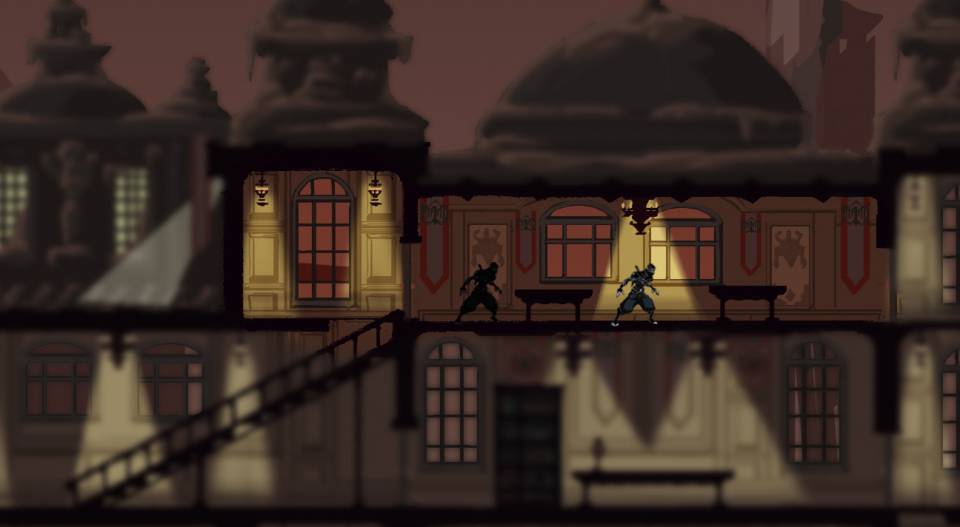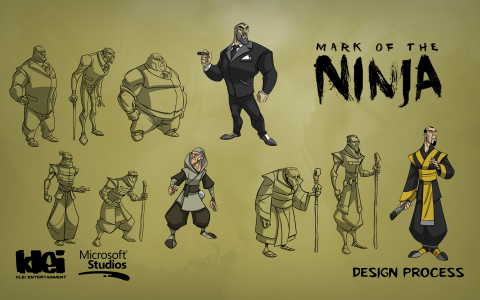
"I wish more people would acknowledge the fact that all games are really shit for a long time,” said Mark of the Ninja lead designer Nels Anderson.
It’s easier, of course, to say that when much of the world has declared your latest game a massive success.
Anderson just returned from a two-week jaunt to Ireland and Scotland, a well-earned break following the launch of Mark of the Ninja. The reprieve ended as quickly as it began. Upon his return, Anderson was right back into the thick of it, helping his team prepare the acclaimed 2D stealth game for its PC release. That happened yesterday on Steam.
When Mark of the Ninja’s life began, Anderson wasn’t even employed at the Vancouver-based Klei Entertainment. It wasn’t his fault, though. He was laid off from Klei following a project cancellation in early 2009, and he moved onto the Deathspank games at Hothead Games. Anderson did come back to Klei in late 2010, around the time Microsoft had signed off on a pitch for a ninja-centric game from the studio called...Ninja.
This is the pitch video that sold Microsoft on what would eventually become Mark of the Ninja:
None of that is playable. Zero. It was all made in Flash. Klei built the video in about three weeks, which was followed by months of contract negotiations with Microsoft. In the meantime, Anderson was recruited for the project. On the surface, so much much of what became Mark of the Ninja seems apparent in the pitch video.
“When you look at that, it’s like...it’s not that far off, really,” he said. “Obviously, none of the visual perception stuff is in there, but otherwise, it kind of feels like the game. It’s a little more brawler-y maybe, but it’s not that far off.”
Anderson had much to do with Mark of the Ninja’s development, but nothing to do with this video. Klei CEO Jamie Cheng showed Anderson the video upon his return to Klei, and immediately became excited about its prospects. A longtime devotee of Thief, Metal Gear Solid and other stealthy games, it was a chance to contribute to the genre.
The pitch video is flashy and neat, but not representative of the work ahead for Anderson’s team, which is why I asked him to send along video after the real work of building the game had started.
“I looked at that and just went ‘oh, holy shit,’” he said.
The time stamp on that video is April 2011--two months of work on Mark of the Ninja. The game was finished in August of this year. The temporary sound effects are hysterical, and the amount of on-screen text explaining the game makes you wonder if the game was, at one point, much more hand-holdy than it eventually became.
“That was, basically, to help Microsoft understand what we were trying to do with those phases,” he said. “If you know what’s going on, you can see through it and get it, but if you don’t really know what’s going on, it’s really easy to not pick up on that stuff, especially when the fidelity is so low and everything else is so rough."

Klei had a much different vision of the structure of the game around this time, which Anderson compared to Super Meat Boy. There would be six distinct worlds, each with different motif, and every stage would have a handful of encounters for players to work through. The plan was for roughly 60 stages, with the player ultimately working towards the assassination of a single target.
“Constructing the levels in that way was alright, but it just didn’t have a super strong sense of place,” he said.
Narrative designer and former Kill Screen editor Chris Dahlen was not involved at this point, and there wasn’t much of a story. The game did have several boss characters, one of which was a CEO-type that would become Karajan in the final game.
You'll notice the main character keeps slipping in and out of linework in the video. That’s because, at the time, all of the animation frames were being hand drawn. This was a different approach from the two Shank games, which used "character builds." In essence, a character model is created with a bunch of modifiable pieces, and those pieces are altered to create the animation. That’s an oversimplification of the process, but it’s what allows for a hand drawn look without actually drawing every individual frame. Mark of the Ninja embraced hand drawn before memory constraints on the Xbox 360 forced them to retreat. In retrospect, though, Anderson said it was right decision all along; if the team spent hours on animation that had to be ditched because a feature didn’t work, that’d be demoralizing.
There are plenty of other gameplay flourishes touched upon in the video that never materialized, too.
Klei planned for surfaces to produce varying levels of noise, but couldn’t find a way to represent it easily in 2D. There was a killing dart that playtesting revealed broke the game--players slaughtered everyone. A mortar and pestle item was rolled into the smoke bomb. Objects once had flammability attributes, so players could have more ways to distract the guards. The team worked through three different design ideas for combat, including one that gave players the ability to run around with a sword and hack dudes up. Another resulted in one-on-one parrying matches.
Every ditched design idea was in service of making a better game, even when it was painful to do so.

Perhaps the most substantial change was completely getting rid of an additional range of movement. For a while, the game provided players three options: run, walk, sneak. Sneaking produced no noise, walking produced a little noise, and running produced a ton of noise. Sneaking and running were mapped to the triggers, and in order to pull off movements like crawling up building edges, you’d have to hold down the stealth button.
“No one moved at the walking speed--ever," he said. "In all the playtesting stuff we did, either people were sneaking or running. They were never really walking. What’s the point of having this here, then? The only reason that was meritorious was it provided a contrast. When you pulled down that sneaking trigger, you really did feel like you were sneaking, but that alone was not enough to keep this thing that wasn’t giving us anything else.”
The other problem? The team ran out of buttons on the Xbox 360 controller. Serendipity.

Between the pitch and prototype video, it looks like so much of what would come to define Mark of the Ninja had been worked out early on, but Anderson painted a much darker, more frustrating picture.
“The funny thing about Ninja is that getting the baseline stuff up and running wasn’t that tricky--we had that going,” he said. “But then there was this big, big, big gulf. Getting a little bit of the way? Really easy. The next big chunk? That was the stuff that was really, really, really, really hard. If you look at that level, as an example, it doesn’t seem in any way, shape or form like a real place. It’s just some bullshit nonsense--platforms, walls, whatever. Even that seemingly mundane thing, where we need to make this space feel grounded and real, but still afford all the gameplay stuff we want to do, was not easy. Watching the prototype video. All of the sound and perception stuff is there--but without the sound rings being there, I’m like ‘how the hell did we think anybody would ever play this?’”
It’s easier to laugh about it now, given how well the systems now interact, but Anderson expected Microsoft to drop the hammer at some point. There was a long stretch where Mark of the Ninja was just not very fun to play, and though the team was making progress in the right direction, it was hard to remind yourself that on a day-to-day basis.
“Probably about this time last year, we were ‘oh, god, they’re totally going to pull the plug, they’re totally going to do it!’” he said. “And they never did.”
One of the biggest hurdles for Mark of the Ninja was iterating on the game’s core: stealth. While Mark of the Ninja was finding itself, the team knew it was onto something with 2D stealth, but it wasn’t clicking. Discouraged, the team focused on expanding combat and other elements, including a focus on psychological warfare. The game had “terror items,” and a bigger focus on manipulating guards against one another. All this did was distract Mark of the Ninja from its original vision, and push the team away from confronting the game’s most pressing problems.
“We were treating the symptoms of the stealth not being super fun but by adding something else to accommodate for it,” he said, “rather than figuring out why the sneaking bits aren’t fun. I’m glad we didn’t keep going down that road.”
Obviously, it worked out. Mark of the Ninja is great. Really great, actually. You should play it, even if you don’t care for stealth. For Anderson, it’s rewarding to know he’s contributed to a genre he cares so deeply about.
“I do like these games so much, and it’s really cool that maybe I can offer other people a window into why the hell I like them as much as I do,” he said.

















